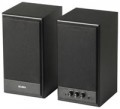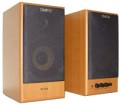Sensitivity
Sensitivity characterizes the loudness of the speakers when a signal of a certain power is applied to them. The higher this indicator, the higher the volume will be with the same characteristics of the signal source; simply put, on the same computer and the same volume settings, more sensitive speakers will play louder.
In general, an indicator of 85 dB is considered good, 90 dB and above is excellent. On the other hand, computer speakers rarely need a very high volume — they are usually located close to the user and are designed only for him. So in general, this parameter can be ignored.
Signal-to-noise ratio
The ratio of the level of the useful signal (actually reproduced sound) to the level of extraneous noise provided by the speaker amplifier in normal mode.
Any amplifier inevitably creates its own noise; You can't get rid of them, but you can reduce their level. The higher the signal-to-noise ratio, the clearer the sound will be, the less noticeable extraneous interference will be. In modern computer speakers, this figure can vary from 52 – 55 dB (the minimum figure so that the noise does not cause much discomfort) to 90 – 95 dB (comparable to fairly advanced Hi-Fi equipment). However, note that the signal-to-noise ratio is far from the only parameter that affects the sound quality, and its high value does not guarantee a pleasant sound from the speakers.
Frequency range
The range of audio frequencies supported by acoustics. The wider this range — the fuller the reproduced sound, the lower the likelihood that some of these details at low or high frequencies will remain “behind the scenes”. At the same time, the human ear is able to hear frequencies of the order of 16 – 22,000 Hz, and with age, this range narrows even more. In modern audio equipment, especially at the top level, there may be more extensive ranges, but from a practical point of view, this does not make much sense. In addition, it is worth noting that a wide frequency range in itself does not guarantee high-quality sound — a lot also depends on the frequency response.
Impedance
The electrical resistance of the speakers to alternating current. This parameter is important primarily for normal compatibility with the amplifier: too low speaker impedance can lead to distortion, overload, and even damage to the speakers, and too high impedance can reduce the sound volume. At the same time, the vast majority of modern computer acoustics have their own amplifiers and are connected via a line input. Therefore, the impedance data is more of a reference value; in fact, this indicator may be needed only when connecting speakers to a “non-native” power amplifier, bypassing the standard one.
Speaker port tube
A phase inverter is a tube of a special design that connects the inner volume of the speaker housing with the outer space. Due to the precisely selected length, such a tube improves the sound of low frequencies, making it more saturated and uniform. The main disadvantage of a phase inverter is that a hum may occur due to the movement of air in the tube; however, manufacturers design speakers in such a way as to minimize the likelihood of this phenomenon.
Note that the presence of a phase inverter is especially useful for subwoofers, but this feature can also be found in general-purpose stereo speakers — for the same reasons.
Connections
—
mini-Jack (3.5 mm). The 3.5 mm jack is used as a standard analogue audio output in almost all modern PCs and laptops; in addition, it is installed in most smartphones, tablets and pocket players, and in many other types of technology is very common. Thus, most modern computer speakers are equipped with a mini-jack plug (with the exception of Bluetooth models). This can be a plug on a non-detachable or detachable cable, or an adapter from another connector — for example, “2 RCA — mini-jack”.
— RCA.
RCA connector, also colloquially known as a "tulip", in this case is used as a line input, for receiving an analogue audio signal — similar to the same 3.5 mm mini-jack. The differences lie in several important points. First, RCA works on the principle of "one connector per channel", and the number of such connectors will depend on the audio format. For example, stereo acoustics will need a set of two such connectors, a 5.1 system will need six, etc. Secondly, RCA is quite popular in traditional audio equipment, but it is rather uncommon among computers. Therefore, this input is relatively rare in computer acoustics — mainly in fairly advanced models (including solutions with an external amplifier). In addition, we note that in sets with a subwoofer for connecting a “sub” in the main satellite, an RCA connector can also be provided, which in this case plays the role of an output.
—
Subwoofer output. The presence of a connector for connecting a subwoofer allows you to further saturate the sound of the system with low frequencies. Naturally, a subwoofer is purchased separately. And the output itself serves as an option and allows you to expand the acoustics as needed.
—
Headphone output. Headphone output located directly on the body of one of the speakers. Such a connector can be especially convenient when using headphones with a traditional desktop PC: connecting the “ears” to the speaker housing on the table can be much more convenient than pulling the wire to the system unit. Usually, the role of this output is played by a standard mini-Jack 3.5 mm jack — it is under it that most modern "ears" (both computer and general-purpose) are made.
—
Microphone input. An input for connecting an external microphone, located directly on the speaker cabinet. The meaning of this function is the same as that of the headphone output described above: it is often more convenient to connect a microphone to a speaker standing on a table than directly to the system unit. The speakers themselves with this feature, usually, have an additional plug connected to the microphone input of the sound card.
—
USB B. An interface that allows you to connect speakers to the USB port of a computer, laptop, etc. as an external peripheral. Such a connection can be useful, for example, in cases where the standard audio output is busy or located in a hard-to-reach place; in addition, it allows the speakers to work even if there is no sound card in the system (although this is very rare today). At the same time, speakers can also be powered via USB, which, with low power, makes it possible to do without a separate power source (for more details, see "Power from the USB port"). In addition, this connector may be responsible for additional functions — for example, controlling speaker functions from a PC through special software.
—
Optical input. Digital input for high quality sound transmission, including multichannel. Such a connection is remarkable for its complete insensitivity to electrical interference, however, the fibre optic cable does not tolerate bending and strong pressure.
—
Coaxial input. Digital audio input. Provides the possibility of transmitting multi-channel audio. Uses an RCA connector (colloquially referred to as a "tulip"), but is not compatible with the RCA interface described above. A coaxial connection, unlike an optical one, is subject to electromagnetic interference, but it does not require special delicacy in handling the cable.
Detachable cable
The presence
of detachable cables will save you from possible damage to the device associated with bending the wires. If such an incident occurs, an easy replacement of the wire with a new one allows you to continue using the speakers, and not carry them to a service centre. However, this solution is mainly used in higher-level models, which affects the cost. At the same time, not only audio cables can be removable, for which connectors are provided (according to the classics, this is RCA), but also the power cable.

